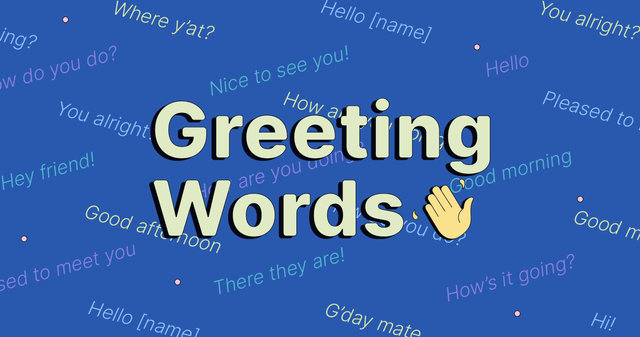Exploring Lesser-Known Greetings: A Guide for Non-Native English Speakers

Greetings are the cornerstone of social interactions, yet for non-native English speakers, navigating the diverse landscape of English greetings can be a challenge. While "hello" and "goodbye" are universal, English harbors a variety of greetings with unique nuances and contexts. Let's explore some greetings that often escape the notice of non-native speakers and learn when and how to use them effectively.
1. "Howdy" (United States)
Originating from the American West, "Howdy" is an informal greeting meaning "How do you do?" It's commonly used in casual settings, particularly in rural or Southern regions of the United States. Non-native speakers can use "Howdy" to convey friendliness and informality, especially when meeting someone for the first time.
2. "Cheers" (United Kingdom, Australia, New Zealand)
Although commonly associated with toasting drinks, "Cheers" is also used as a casual greeting in English-speaking countries like the UK, Australia, and New Zealand. It's a versatile term, suitable for both formal and informal occasions. Non-native speakers can use "Cheers" to express gratitude, agreement, or as a simple salutation in social settings.
3. "What's up?" (United States)
A popular informal greeting in American English, "What's up?" is a colloquial way to ask how someone is doing or what they are currently doing. It's often used among friends and peers in casual conversations. Non-native speakers should be aware that "What's up?" is best suited for informal situations and might be considered too casual for professional settings.
4. "G'day" (Australia)
As iconic as kangaroos and koalas, "G'day" is an informal greeting synonymous with Australian culture. Short for "Good day," it's used throughout the day to greet friends, colleagues, and strangers alike. Non-native speakers can embrace the laid-back Aussie spirit by using "G'day" in informal settings to convey friendliness and camaraderie.
5. "Alright?" (United Kingdom)
A quintessential British greeting, "Alright?" might sound like a question, but it's often used as a casual greeting similar to "How are you?" It's commonly heard in the UK and can be used among friends, acquaintances, and even strangers in informal settings. Non-native speakers can adopt "Alright?" to add a touch of British flair to their conversations.
6. "Yo" (Informal)
Derived from African American Vernacular English (AAVE), "Yo" is an informal greeting widely used in urban and youth cultures. It's short, casual, and often accompanied by a nod or wave. Non-native speakers should use "Yo" sparingly and be mindful of the context, as it may come across as too informal or even disrespectful in certain situations.
7. "How's it going?" (United States)
A common informal greeting in American English, "How's it going?" is a casual way to ask about someone's well-being or what they've been up to lately. It's suitable for both friends and acquaintances in informal settings. Non-native speakers can use "How's it going?" to initiate conversations and show genuine interest in the other person's life.
Mastering the art of English greetings goes beyond the basics of "hello" and "goodbye." By familiarizing themselves with these lesser-known greetings and their appropriate contexts, non-native English speakers can enhance their communication skills and build stronger connections with native speakers. So whether it's a hearty "Howdy" in Texas or a cheerful "G'day" in the Outback, let's embrace the richness of English greetings and the cultural diversity they represent.
Stay tuned for our upcoming website SteadySpeaker
Upvoted. Thank You for sending some of your rewards to @null. It will make Steem stronger.